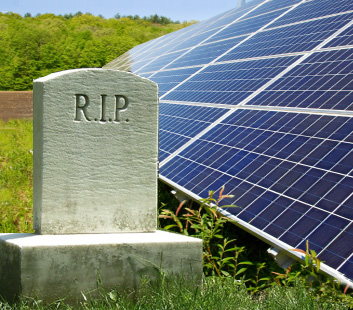 The solar company Solyndra recently filed for bankruptcy, which media reports have depicted as the end of solar power in the U.S. This is like saying there is no future for the internet because Netscape went out of business.
The solar company Solyndra recently filed for bankruptcy, which media reports have depicted as the end of solar power in the U.S. This is like saying there is no future for the internet because Netscape went out of business.
The molar-grinding irony of it all is that Solyndra was the victim of a big success — the price of solar power has fallen rapidly, making more expensive technologies like theirs uncompetitive, but more importantly, making solar power a real player in the U.S. energy economy.
Since October of 2008, the average price of solar modules has fallen from $4.20 per watt to around $1.20 to $1.50 per watt today. These are mind-boggling reductions. And these new prices are resulting in extraordinary market development. As of June, California utilities have signed over eight gigawatts of solar contracts … half of which are below the price of new natural gas generation. That’s right. Gigawatts of solar cheaper than the fossil fuel alternatives.
The media have been hinting at scandal and impropriety. While we have no idea about Solyndra’s actions in securing the loan guarantee, we can say that their technology approach was squarely within mainstream thinking of the time. Solyndra was attempting to develop a photovoltaic (PV) technology that didn’t use silicon, the dominant raw material for PV then and today. Take a look at this chart [PDF]. For years, silicon was manufactured primarily for semiconductors, and the solar industry essentially relied on excess material. In 2004, when Germany introduced robust incentives and the solar industry really started taking off, a shortage of silicon became a huge problem. There were seven plants in the world capable of manufacturing solar grade silicon, and as they had the scarcity in the value chain, they were able to command premium prices. The market price of silicon went through the roof. The main material for crystalline PV technology, which once cost $25 per kilogram (kg), soared to $450 per kg. Silicon manufacturers had the solar industry by the short hairs, and everyone looked for an alternative. Silicon was the single biggest obstacle to bringing down costs and bringing solar to scale, and everybody — absolutely everybody — was trying to figure out how to deal with it.
Solar manufacturers that had relied on silicon-based PV technology tried to develop new methods that didn’t need silicon. For example, Sharp, which was once the world’s largest PV manufacturer using crystalline silicon technology, made a significant capital investment in a thin-film product that was half as efficient … but used about 1 percent of the silicon [PDF]. And venture-capital money poured into start-ups working on breakthrough new materials that addressed the silicon problem. Nanosolar, Miasole, HelioVolt, and, yes, Solyndra, all received hundreds of millions of dollars of private venture funds to commercialize CIGS technology — an approach that did not rely on any silicon at all. Solyndra’s premise was squarely within mainstream thinking.
So what happened? Silicon got cheap, and the manufacture of crystalline silicon panels got even cheaper. All the innovation, market pressures, and government investment worked. Analysis out today from the DOE’s Lawrence Berkeley National Lab shows that the pre-incentive price of going solar in the U.S. dropped 17 percent last year, and another 11 percent in the first half of 2011 — record reductions since they began tracking the data. Importantly, the Berkeley Lab report further indicates that federal and state market-building policies have been instrumental to those gains. What little policy support solar has received relative to its fossil counterparts is working as it should — to build scale, bring down costs, and deliver strong economic returns on our nation’s investment. And today the solar power industry is the fastest-growing industry in America.
The holy grail of those working in the field is to bring down costs. Solyndra had a reputed cost structure around $2 per watt. The fact that’s no longer competitive is a sign that solar is succeeding, and delivering on its promise faster and better than the brightest minds and the big bucks ever imagined.



